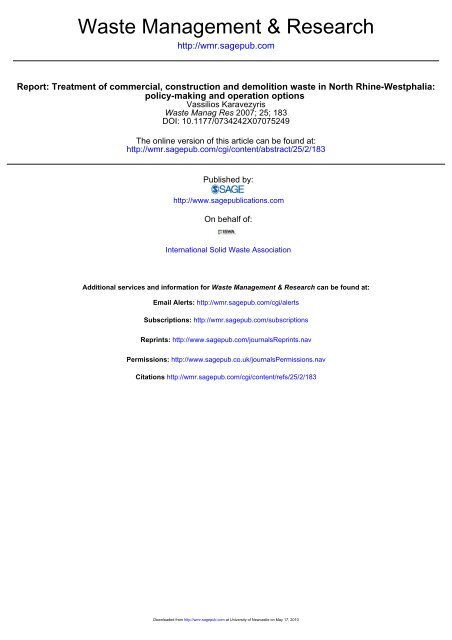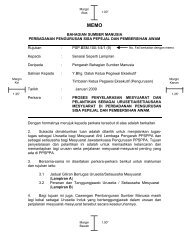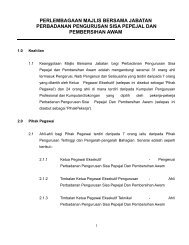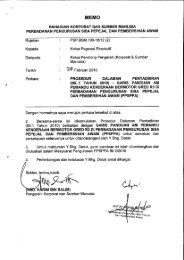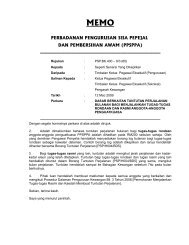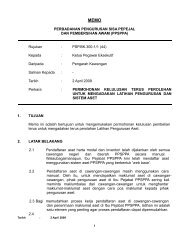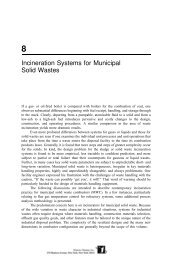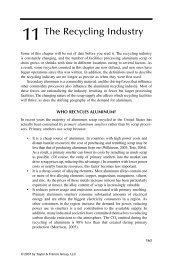Waste Management & Research
Waste Management & Research
Waste Management & Research
Create successful ePaper yourself
Turn your PDF publications into a flip-book with our unique Google optimized e-Paper software.
<strong>Waste</strong> <strong>Management</strong> & <strong>Research</strong><br />
http://wmr.sagepub.com<br />
Report: Treatment of commercial, construction and demolition waste in North Rhine-Westphalia:<br />
policy-making and operation options<br />
Vassilios Karavezyris<br />
<strong>Waste</strong> Manag Res 2007; 25; 183<br />
DOI: 10.1177/0734242X07075249<br />
The online version of this article can be found at:<br />
http://wmr.sagepub.com/cgi/content/abstract/25/2/183<br />
Published by:<br />
http://www.sagepublications.com<br />
On behalf of:<br />
International Solid <strong>Waste</strong> Association<br />
Additional services and information for <strong>Waste</strong> <strong>Management</strong> & <strong>Research</strong> can be found at:<br />
Email Alerts: http://wmr.sagepub.com/cgi/alerts<br />
Subscriptions: http://wmr.sagepub.com/subscriptions<br />
Reprints: http://www.sagepub.com/journalsReprints.nav<br />
Permissions: http://www.sagepub.co.uk/journalsPermissions.nav<br />
Citations http://wmr.sagepub.com/cgi/content/refs/25/2/183<br />
Downloaded from<br />
http://wmr.sagepub.com at University of Newcastle on May 17, 2010
<strong>Waste</strong> Manage Res 2007: 25: 183–189<br />
Printed in UK – all right reserved<br />
Copyright © ISWA 2007<br />
<strong>Waste</strong> <strong>Management</strong> & <strong>Research</strong><br />
ISSN 0734–242X<br />
Report: Treatment of commercial, construction<br />
and demolition waste in North Rhine-Westphalia:<br />
policy-making and operation options<br />
This paper summarizes a long-term-investigation of the<br />
mechanical treatment of commercial, construction and demolition<br />
waste materials in North Rhine-Westphalia in the<br />
light of applied operation standards and a disposal ban on<br />
untreated waste. It is shown how both the allocation of output<br />
materials from mechanical treatment plants and the subsequent<br />
treatment channels have changed since enforcement of<br />
the ban in 2005. Based on the findings of the investigation,<br />
two waste management scenarios offering alternative policies<br />
have been defined and are discussed. It is suggested that consistent<br />
enforcement of the ban affects both the diversion of<br />
waste to incineration and the recovery of materials on a<br />
regional scale. On the other hand, potential energy recovery<br />
may be fully exploited only insofar as operators of mechanical<br />
treatment plants concentrate their business on the production<br />
of refuse-derived fuel.<br />
Introduction<br />
Under German legislation, the treatment of commercial waste,<br />
construction and demolition waste is controlled in such a way<br />
that private enterprises do not have direct access to the disposal<br />
market unless they are invited to participate in public–<br />
private partnerships. On the other hand, waste treatment may<br />
be left to private business provided their aim is the recovery of<br />
materials. Against this background, waste generators and disposers<br />
have frequently in the past declared their waste to be<br />
waste for recovery in order to avoid high disposal costs. The<br />
ultimate location of these so-called dummy-recovered waste<br />
materials has been dump sites with low environmental standards,<br />
often beyond national borders. This has also led to overcapacity<br />
in the existing mass-burn incinerators leading to<br />
increasing specific operation costs and waste fees.<br />
Vassilios Karavezyris<br />
Federal Ministry for the Environment, Nature Conservation and<br />
Nuclear Safety Division WA II 1. Principal Matters of <strong>Waste</strong><br />
<strong>Management</strong>, Transboundary Movement of <strong>Waste</strong>s, Bonn,<br />
Germany<br />
Keywords: Commercial wastes, disposal ban, mechanical waste<br />
treatment, North-Rhine Westphalia, wmr 963–5<br />
Corresponding author: Dr Vassilios Karavezyris, Federal<br />
Ministry for the Environment, Nature Conservation and Nuclear<br />
Safety Division WA II 1. Principal Matters of <strong>Waste</strong><br />
<strong>Management</strong>, Transboundary Movement of <strong>Waste</strong>s, Robert-<br />
Schumen-Platz 3, P.O. Box 12 06 29, D-53048, Bonn, Germany.<br />
Tel: +49 228 99 305 2565; fax: +49 228 99 10 305 2565;<br />
e-mail: vassilios.karavezyris@bmu.bund.de<br />
DOI: 10.1177/0734242X07075249<br />
Received 9 January 2006; accepted in revised form 20 November 2006<br />
Figures 1, 2 appear in color online: http://wmr.sagepub.com<br />
The German legislature has reacted to dummy recovery<br />
by imposing special ordinances derived from the Closed Substance<br />
Cycle and <strong>Waste</strong> <strong>Management</strong> Act (Krw/-AbfG 1994).<br />
The <strong>Waste</strong> Storage Ordinance (AbfAblV 2001) imposed a<br />
ban on the disposal of waste that has total organic carbon<br />
content greater than 3% in landfills for municipal waste; this<br />
regulation came into effect on 1 June 2005. The underlying<br />
idea was that recoverable substances were to be separated in<br />
state-of-the-art installations and the energy from the waste<br />
was to be utilized. Only a small non-recoverable part would<br />
remain and have to be stored in well-equipped landfills (BMU<br />
2005).<br />
Additional legal actions to promote recovery have been<br />
imposed by the Commercial <strong>Waste</strong> Ordinance (GewAbfV<br />
<strong>Waste</strong> <strong>Management</strong> & <strong>Research</strong> 183<br />
Downloaded from<br />
http://wmr.sagepub.com at University of Newcastle on May 17, 2010
V. Karavezyris<br />
2003), which is focused on separation, pre-treatment and<br />
recovery quotas (up to 85%) for commercial waste that originates<br />
from commerce and trade, small businesses, office buildings<br />
and institutions as well as construction and demolition<br />
waste. These two groups are defined with codes 20 03 01 and<br />
17 09 04 in the European List of <strong>Waste</strong>s (COM 2000) and<br />
are hereafter denoted as Cw and CDw.<br />
This paper is focused on the mechanical treatment waste<br />
in North Rhine-Westphalia (NRW) which, with approximately<br />
18 million inhabitants, is the largest of 16 German<br />
States. The total amount of municipal solid waste generated<br />
(including separately collected fractions) is approximately<br />
14 million Mg year –1 . The current requirements for pre-treatment<br />
are covered by 16 mass-burn incinerators (total capacity:<br />
5.4 million Mg year –1 ) as well as by four mechanical–biological<br />
treatment plants (total capacity: 0.5 million Mg year –1 ).<br />
The Environmental Ministry of NRW has conducted a longterm<br />
investigation in order to evaluate the impact of the ban<br />
on the disposal of untreated waste for the operation and outputs<br />
of mechanical waste treatment plants (MTPs) for Cw<br />
and CDw (MUNLV 2006). The investigation was carried out<br />
in two phases. In the first phase (years 2003–2005) basic<br />
information on number of installations, capacities, and treatment<br />
channels was obtained. Ample data spread in various<br />
State authorities were systematically collected, verified and<br />
evaluated in co-operation with external waste management<br />
experts. During the second phase (2006), the Environmental<br />
Ministry conducted two questionnaire surveys that addressed<br />
operators of plants for mechanical treatment of waste in cooperation<br />
with associations of waste management enterprises<br />
in order to verify the findings of the preceding phase and<br />
gain additional information about the impacts of the disposal<br />
ban on the business of mechanical waste treatment and plant<br />
operation. Further information on the output waste streams<br />
from mechanical treatment plants and treatment channels<br />
was evaluated using additional sources; for example, data<br />
from mass-burn incineration that were available to the Environmental<br />
Ministry.<br />
184 <strong>Waste</strong> <strong>Management</strong> & <strong>Research</strong><br />
Capacities and standards for mechanical<br />
waste treatment<br />
In total, 169 MTPs for treatment of Cw and CDw were identified<br />
and analysed with regard to their permitted capacity,<br />
waste codes for the types of waste treated, technical assets and<br />
mass flows in the reference year, 2003. A total of 156 MTPs<br />
used one operation line that served for the treatment of Cw,<br />
CDw or, alternatively, separate waste fractions. The remaining<br />
13 MTPs had two or three operation lines, so that they<br />
were able to treat different waste streams at the same time.<br />
The total permitted capacity of all MTPs for treatment of<br />
Cw and CDw in NRW was found to be 14.4 million Mg year –1 ,<br />
which was considered very high. Although the mean MTP<br />
capacity was approximately 112 000 Mg year –1 , more than 75%<br />
of the total capacity was within installations that were larger<br />
than 100 000 Mg year –1 . In NRW the permitted capacities varied<br />
from 37 000 Mg year –1 (arithmetic mean for District of Detmold)<br />
to 180 000 Mg year –1 (arithmetic mean for District of<br />
Düsseldorf).<br />
It is noteworthy that a large proportion of the installed<br />
capacities referred to MTPs with low or medium standards<br />
(Table 1). This is in contrast to the high standards of the other<br />
treatment (thermal and mechanical–biological) and disposal<br />
options for municipal waste that are actually in place in<br />
NRW.<br />
With regard to the installations for treatment of Cw, capacities<br />
of approximately 3.6 million Mg year –1 were associated<br />
with a few, simple operation units, such as sorting with a wheel<br />
loader. The respective installations were usually dominated<br />
by an open space; where waste materials were tipped and<br />
roughly pre-sorted (e.g. fractions such as wood, plastics etc.)<br />
in order to be further processed at an external recovery facility.<br />
Bulky refuse, such as carpets and mattresses, would be<br />
removed and transferred for disposal. The occurrence of other<br />
equipment, such as crushers, was less frequent. Slightly more<br />
than half of the installations for treatment of Cw, amounting<br />
to capacities for 7.9 million Mg year –1 , were classified as installations<br />
with medium standards. At these sites machine sort-<br />
Table 1: Allocation of capacities for treatment of Cw and CDw with respect to mechanization standard (Mg year –1 and %).<br />
Low standard (a) Medium standard (b) High standard (c) Total<br />
(Mg year –1 ) (%) (Mg year –1 ) (%) (Mg year –1 ) (%) (Mg year –1 )<br />
Cw 3 651 308 27 7 877 746 58 1 992 500 15 13 521 554<br />
CDw 15 600 2 812 000 98 0 0 827 600<br />
Total 3 666 908 26 8 689 746 61 1 992 500 14 14 349 154<br />
(a) Low standard: reception area and equipment for sorting, crushing or shredding of wastes; basically pre-treatment.<br />
(b) Medium standard: advanced shredding and screening equipment, air separators and electro-magnetic separators; possible production of<br />
medium-calorific RDF.<br />
(c) High standard; advanced technologies, e.g. NIR, eddy-current and ballistic separators; possible production of high-calorific RDF.<br />
Downloaded from<br />
http://wmr.sagepub.com at University of Newcastle on May 17, 2010
ing not only sorted out disposable wastes but also protected<br />
the subsequent equipment from inappropriate, bulky wastes.<br />
More demanding machinery, such as air separators and<br />
magnetic separators combined with hand sorting could be<br />
used for the production of fractions with high net calorific<br />
values. In order for these separate high calorific fractions to<br />
be used for energy recovery, such as co-incineration in power<br />
stations or cement kilns, further preparation of refuse-derived<br />
fuel (RDF) in external installations would be needed. Finally,<br />
only 16 from 159 plants with a total capacity of almost<br />
2 million Mg year –1 were considered to meet a high technical<br />
standard. These plants could produce differentiated outputs,<br />
for example, through near infrared spectroscopy (NIR)-separation<br />
of polymers. Additionally, they facilitated production<br />
of high-calorific RDF, for example by using ballistic separators<br />
or other classifying equipment, which separated light and flat<br />
pieces from heavy, rolling pieces.<br />
<strong>Waste</strong> streams and treatment channels<br />
Before the disposal ban for untreated wastes<br />
It was found that for Cw a total of 7.8 million Mg year –1 were<br />
input and 7.4 million Mg year –1 were output from the 169<br />
MTPs (It should be noted that the compilation of existing<br />
data was based on MTP-throughputs rather than waste generation<br />
and so the total outputs of the MTPs presented in<br />
this section are higher than waste actually disposed of and/or<br />
recovered.). Approximately 80% of the inputs were related<br />
to four categories of origin, namely those described in chapters<br />
15, 17, 19 and 20 of the European List of <strong>Waste</strong>s (COM<br />
2000). Of these, waste from mechanical treatment constituted<br />
the biggest input, indicating operation ‘cascades’, (code<br />
19 12 12, almost 20%), followed by CDw (code 17 09 04,<br />
14%), packaging wastes (code 15 01 06, 12%) and Cw (code<br />
20 03 01, 3.4%). Approximately 0.8 million Mg year –1 of<br />
waste coded 19 12 12 was imported from abroad, particularly<br />
the Netherlands. The proportion of Cw in the total inputs<br />
was apparently low, which may be justified by the assumption<br />
that holders and operators declared their waste materials in<br />
such a way that they were not subject to recovery quotas<br />
according to the Commercial <strong>Waste</strong> Ordinance (GewAbfV<br />
2003). The difference between total inputs and outputs, which<br />
amounted to approximately 5%, could presumably be attributed<br />
to an increase in the waste quantities stored at the plants.<br />
Columns 1 and 2 in Table 2 show the allocation of output<br />
waste fractions as well as various treatment channels for all<br />
output. Materials recovery greatly exceeded any thermal<br />
treatment as well as all landfilling, the latter representing a<br />
little more than one-quarter of total treatment (disposal and<br />
recovery). On the other hand, a large portion of the output<br />
waste fractions (61%) was deemed to be residuals from<br />
Treatment of commercial, construction and demolition waste in North Rhine-Westphalia<br />
Table 2: Output waste fractions and treatment of Cw and CDw in NRW<br />
before and after 1 June 2005 (%).<br />
Output waste fraction Survey 2003–2005 Survey 2006<br />
Polymers 1 6<br />
Paper 5 9<br />
Wood 4 15<br />
Metals 1 4<br />
RDF 2 5<br />
Other materials 1 3<br />
Minerals* 25 3<br />
Fine fractions* – 18<br />
Residuals 61 37<br />
Total 100 100<br />
Treatment option Survey 2003–2005 Survey 2006<br />
Material recovery 57 47<br />
Mass-burn incineration 8 33<br />
Co-incineration 6 2<br />
Dedicated RDF incineration – 7<br />
Mechanical treatment – 1<br />
Landfill 29 10<br />
Total 100 100<br />
*Mineral and fine fractions evaluated together in survey 2003.<br />
–, No separate measurement available.<br />
mechanical treatment that were processed to further recovery<br />
or disposal. A closer look at treatment channels and output<br />
waste fractions showed that only a part of residuals went<br />
into a disposal operation. As a matter of fact, waste from the<br />
mechanical treatment of waste (coded with 19 12 12) may<br />
have included both separate fractions such as polymers, etc.<br />
that were suitable for recovery as well as residuals that could<br />
not be further used. It appears that approximately 45% of the<br />
19 12 12 wastes, i.e. 27% of the total output was processed in<br />
a recovery operation<br />
It was also interesting to see the allocation of treatment<br />
channels in the light of the applied technologies in the MTPs.<br />
Evaluation of the survey (not further presented here) showed<br />
that there was a substantial shift of treatment options from<br />
disposal to recovery according to underlying mechanization<br />
standards. Whereas MTPs of low standard produced almost<br />
60% output for disposal, such output from an MTP with high<br />
standards was limited to 15%. A second important shift was<br />
related to the recovery options. Whereas energy recovery did<br />
not exceed 8% when high calorific fractions were produced<br />
in MTPs with medium standard, it reached a level of 30% in<br />
the case of high-standard MTPs.<br />
After the disposal ban for untreated wastes<br />
The updated information refers only to a proportion of the total<br />
MTPs analysed in the 2003 survey. Thus, direct comparison<br />
<strong>Waste</strong> <strong>Management</strong> & <strong>Research</strong> 185<br />
Downloaded from<br />
http://wmr.sagepub.com at University of Newcastle on May 17, 2010
V. Karavezyris<br />
Fig. 1: MTP-based comparison of waste throughputs according to survey in 2003 and survey in 2006: (a) inputs and outputs (sample: 61 MTPs);<br />
(b) mechanisation standards (2003), inputs and input ranges (sample: 59 MTPs).<br />
of waste throughputs was possible only for samples. For a sample<br />
of 61 MTPs (with total permitted capacity 5.8 million<br />
Mg year –1 ), it was determined that after 1 June 2005 both input<br />
and output were reduced to 45–48% in comparison with the<br />
levels of 2003 (Fig. 1a). The reduction of throughputs was<br />
more incisive for the larger installations. Figure 1b shows a<br />
comparison of the inputs to 59 MTPs in 2003 and 2005. The<br />
inputs of these MTP have been classified to six value ranges<br />
extending to 350 000 Mg year –1 . Obviously the enforcement<br />
of the disposal ban had a tremendous impact on those MTPs<br />
that could accept more than 100 000 Mg year –1 of waste. In<br />
practice, input stops or cuts were imposed by market conditions<br />
186 <strong>Waste</strong> <strong>Management</strong> & <strong>Research</strong><br />
Downloaded from<br />
http://wmr.sagepub.com at University of Newcastle on May 17, 2010<br />
for the output of the MTPs. Higher incineration costs for<br />
waste led enterprises to throttle the operation of their MTPs.<br />
Almost three-quarters of the operators who responded to<br />
the 2006 survey stated that they had problems in finding takers<br />
for the waste output from their MTPs in the period following<br />
the disposal ban. Half of them, again, stated that they<br />
had no method of disposal even by means of shipment to<br />
another German State. It is interesting to note that these<br />
operators were waste management enterprises that did not<br />
participate in the operation of mass-burn incinerators. They<br />
estimated their future need for thermal treatment of their<br />
output to be approximately 0.6 million Mg year –1 .
The reduction in output of MTPs has been accompanied<br />
by a new allocation of waste treatment channels (Table 2,<br />
column 1 and 2). Whereas materials recovery has decreased by<br />
11%, landfilling of CDw has been halved in comparison with<br />
the level of 2003. In parallel with this, immediately after 1<br />
June 2005 the incineration of Cw, whether pre-treated, sorted<br />
etc. or not, reached almost unprecedented peaks. Moreover,<br />
total energy recovery (co-incineration in industrial plants<br />
plus dedicated RDF-incineration) has been slightly increased.<br />
Data on technical assets analysed in the 2003 survey was<br />
not specifically updated. However, it may be assumed that<br />
there was a shift from low standard MTPs to medium standard<br />
MTPs. The quota of more advanced MTPs (Table 1) was<br />
considered to have remained unchanged.<br />
Outlook<br />
Based on this analysis, it appears that a legally enforced ban<br />
for disposal of untreated wastes has played a most influential<br />
role in shaping waste streams and directing treatment channels<br />
for Cw and CDw (Fig. 1a). The impact of the ban has<br />
been obviously greater than the effects exerted by long-lasting<br />
legal definitions, including those on waste hierarchy and<br />
recovery/disposal. Generally speaking, it seems that respective<br />
definitions as proposed by the Commission (COM 2005)<br />
for a new European Directive on waste will be less important<br />
for treatment channels of Cw and CDw.<br />
A side-effect of diverting wastes from landfill is an increased<br />
demand for thermal waste treatment. In spite of higher incineration<br />
prices for both waste generators and operators of<br />
MTPs, most of the 16 mass-burn incinerators for municipal<br />
solid waste are now operated at their maximum capacity.<br />
Incineration of Cw and CDw amounts to approximately<br />
525 000 Mg year –1 and accounts for 38% of the total permitted<br />
capacity. More than half of this quantity, namely 296 000 Mg<br />
year –1 , is derived from mechanical waste treatment that takes<br />
place in NRW (wastes with code 19 12 12), whereas on the<br />
other hand, imports of 19 12 12 waste from abroad have<br />
decreased almost to zero. As in the short term, increases in<br />
waste inputs are only possible to a limited extent, for example<br />
by lowering their heating value, it is unclear whether surplus<br />
untreated waste and treatment ‘bottlenecks’ will arise. At this<br />
point, policy-making is asked to define important parameters<br />
for the treatment of waste which cannot be disposed of immediately<br />
due to a shortage in mass-burn capacity.<br />
From the policy-makers’ point of view, an issue of major<br />
importance is to safeguard both self-sufficiency for waste disposal<br />
and high environmental standards for the linked systems<br />
of waste treatment, disposal and energy recovery. The<br />
Environmental Ministry in NRW is resolutely opposed to<br />
spatial or temporal externalization of this problem, that is,<br />
Treatment of commercial, construction and demolition waste in North Rhine-Westphalia<br />
through intermediate storage or exporting of waste materials.<br />
Instead, both waste generators and disposers are urged to<br />
intensify source separation;<br />
enhance materials recovery and energy recovery;<br />
construct and operate advanced MTPs; and<br />
extend existing capacities for thermal treatment of Cw,<br />
particularly by enhanced utilization of RDF.<br />
It is interesting to look at the implications of these goals in a<br />
generalized waste management framework. Figure 2 summarizes<br />
the information of Table 2 and shows MTP output and<br />
treatment channels for two scenarios of legislation on disposal<br />
in NRW. The output of MTP is deemed to consist of<br />
waste fractions, which are directly forwarded to a recovery<br />
operation and residuals, which may either go to disposal or<br />
recovery. Total mass-burn incineration is here considered as<br />
a disposal operation, an assumption which might well be<br />
modified to waste-to-energy, namely a recovery operation.<br />
(Note that the European Commissions’ proposal on a new<br />
Directive on waste (COM 2005) defines incineration as<br />
energy recovery on the ground of an efficiency formula as<br />
high as 60%. Notwithstanding the arduous legal discussion<br />
on recovery and disposal definitions, attention here should<br />
be paid to the technical aspects of MTP outputs per se.)<br />
Scenario (a) depicts a state of low and medium standard<br />
for total MTPs, the organic output of which may be disposed<br />
of without thermal or other pre-treatment. Materials recovery<br />
(approximately 18%) is not fully exploited, because landfilling<br />
is frequently less expensive than mechanical treatment.<br />
Obviously, a large part of the residuals and mineral<br />
waste fractions from MTP will be recovered provided that<br />
these are processed to further mechanical treatment. Scenario<br />
(b) applies to consistent pre-treatment of Cw before<br />
landfilling (no dummy recovery possible, where no further<br />
significant investment in advanced operation standards is<br />
made). The increase in incineration costs after the disposal<br />
ban for untreated wastes induces additional pressure on MTP<br />
operators and waste generators leading to maximization of<br />
materials recovery (45%). Whereas the potential for less<br />
demanding materials recovery is fully exploited through the<br />
operation of MTPs with low and medium standards, it seems<br />
hardly reasonable to process residuals to further mechanical<br />
treatment before thermal treatment and final disposal. As a<br />
consequence, the proportion of non-recovered residuals is<br />
very high notwithstanding their potential for energy recovery.<br />
The transition from scenario (a) to scenario (b) suggests<br />
that consistent enforcement of the disposal ban affects the<br />
diversion of waste to incineration but does not guarantee<br />
energy recovery as a whole. It also depicts a trade-off between<br />
<strong>Waste</strong> <strong>Management</strong> & <strong>Research</strong> 187<br />
Downloaded from<br />
http://wmr.sagepub.com at University of Newcastle on May 17, 2010
V. Karavezyris<br />
Fig. 2: Estimations for output proportions of MTP and treatment operation for Cw and CDw in NRW; (a) before enforcement of landfill ban (b) after<br />
enforcement of landfill ban.<br />
materials recovery and energy recovery, as described by Preetz<br />
(2005). Given the current state of materials recovery, the<br />
emerging question is how to achieve higher quotas in energy<br />
recovery. In technical terms, this is quite possible insofar as<br />
innovative engineering concepts are realized. Energy recovery<br />
may be optimized with respect to both medium<br />
(14 MJ Mg –1 ) and high calorific RDF (20 MJ Mg –1 or<br />
higher). Whereas negatively selected, medium calorific RDF,<br />
References<br />
AbfAblV ( Abfallablagerungsverordnung) (2001) Ordinance on the environmentally<br />
compatible storage of waste from human settlements of<br />
2001. Federal Law Gazette, I, 305.<br />
BMU (Bundesministerium für Umwelt, Naturschutz und Reaktorsicherheit)<br />
(2005) A milestone for environmental protection: landfilling of<br />
untreated wastes consigned to the past. From Federal Ministry for<br />
188 <strong>Waste</strong> <strong>Management</strong> & <strong>Research</strong><br />
Downloaded from<br />
http://wmr.sagepub.com at University of Newcastle on May 17, 2010<br />
polluted with higher concentrations of heavy metals, chlorine<br />
and ash content may be prepared for dedicated RDF<br />
incineration, positively selected, quality assured and high calorific<br />
RDF can be directly used in industrial co-incineration.<br />
However, the evaluation of the mechanical waste treatment<br />
presented here indicates that raising energy recovery ultimately<br />
depends on the economically ruled decisions of waste<br />
managers.<br />
Environment, Nature Conservation and Nuclear Safety, www.bmu.de/<br />
waste-management (3.11.2005).<br />
COM (Commission of the European Communities) (2000) Commission<br />
Decision 2000/532/EC of 3 May 2000 replacing Decision 94/3/EC<br />
establishing a list of wastes pursuant to Article 1(a) of Council Directive<br />
75/442/EEC on waste and Council Decision 94/904/EC establish-
ing a list of hazardous waste pursuant to Article 1(4) of Council Directive<br />
91/689/EEC on hazardous waste. Official Journal, L 226, 6.9.2000, p. 3.<br />
COM (Commission of the European Communities) (2005) Proposal of the<br />
European Parliament and the Council on waste, 667 final, Bruxelles.<br />
GewAbfV (Gewerbeabfallverordnung) (2003) Ordinance on treatment of<br />
commercial municipal wastes and certain construction and demolition<br />
wastes. Federal Law Gazette, I, 1938.<br />
KrW/-AbfG (Kreislaufwirtschafts- und Abfallgesetz) (1994) Closed Substance<br />
Cycle and <strong>Waste</strong> <strong>Management</strong> Act of 27 September 1994.<br />
Federal Law Gazette, I, 2705.<br />
Treatment of commercial, construction and demolition waste in North Rhine-Westphalia<br />
MUNLV (Ministerium für Umwelt und Naturschutz, Landwirtschaft und<br />
Verbraucherschutz) (2006) Erhebung des Status quo der Gewerbeund<br />
Baumischabfallaufbereitung in NRW (Survey on status quo of<br />
treatment of commercial, construction and demolition wastes in<br />
NRW) http://www.munlv.nrw.de/sites/arbeitsbereiche/boden/gewerbeabfall.htm.<br />
Preetz, Th. (2005) Brennstoffproduktion aus Gewerbeabfällen (RDF production<br />
from commercial waste). Müll und Abfall, 7, 344–351.<br />
<strong>Waste</strong> <strong>Management</strong> & <strong>Research</strong> 189<br />
Downloaded from<br />
http://wmr.sagepub.com at University of Newcastle on May 17, 2010


